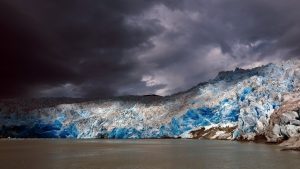Rapid or irreversible change
TerraFIRMA investigates the impact of overshooting key warming targets on phenomena at risk of rapid change (so-called tipping points), including an assessing the potential reversibility of triggered changes.
In addition to the CMIP6 and UKESM experiments, we are using offline models to provide a probabilistic assessment of such risks. Satellite Observations and machine learning (ML) will be used to develop Early Warning indicators for specific tipping points. Work is focusing on, Antarctic ice sheets, marine ecosystems and tropical forests. TerraFIRMA is working with other LTSM2 projects to assess the risk of rapid change in phenomena such as, permafrost, Arctic sea ice, the Atlantic meridional overturning circulation (AMOC) and monsoons. TerraFIRMA also collaborates with recent NERC-funded and Horizon Europe projects addressing Tipping Points in the Earth system. Societal and environmental impacts arising from such rapid changes are assessed in Workpackage 5 (WP5).

Credit: Giuseppe Suaria / Climate Visuals
Antarctic ice sheets: The Antarctic ice sheet (AIS) exhibits extensive evidence of instability and the potential for irreversible change in response to climate change. UKESM1 was the only CMIP6 coupled ESM that included the ice sheets for both Greenland and Antarctica. We are using this unique tool to understand how Earth system interactions affect the stability of marine ice sheets. The long response time of the ice sheet means we need experiments out to 2300 and 2500, where the primary trigger for collapse is the thinning or loss of floating ice shelves. Finally, we will identify early warning indicators of ice sheet collapse, using satellite mapping of grounding line locations.
Marine productivity and ecosystems: Climate change alters the physical and biogeochemical state of the ocean, impacting marine productivity and ecosystems. Some of these changes are abrupt and potentially irreversible. Tipping points in marine ecosystems can be linked to tipping points in the cryosphere (e.g. Arctic sea-ice) or ocean dynamics (e.g. the AMOC), or they can occur independently, through a gradual change in the physical ocean state interacting with biology (e.g. coral reef loss or collapse of the North Atlantic Bloom (NAB)). We are using ML techniques to detect rapid changes and tipping points in marine ecosystems, and to assist in developing early warning systems. Important case studies include the North Atlantic Subpolar gyre and the seasonal NAB of phytoplankton, an annual phenomenon that plays a major role in the North Atlantic carbon sink and in sustaining highly productive ecosystems and fisheries.
Tropical forests are experiencing increased stresses from shifting rainfall patterns, drought and warming temperatures. Human activity is also fragmenting forests, making them more susceptible to environmental stresses. At particular risk is South-east Amazonia, where models project a longer and more intense dry season in the future, potentially leading to forest transitioning to savanna by the end of the century. Forest loss can exacerbate these driving stressors further. For example, increased fire frequency releases aerosols that can alter rainfall distribution, whilst also opening space for faster drying and herbaceous vegetation, increasing fire risk. However, ecosystems can also acclimate to changes in stress, potentially damping the impact of climate change.
TerraFIRMA aims to attribute historic changes in tropical forest to deforestation, natural and human-caused burning, drought and emerging heat stress. We will assess future changes in forest condition, the likelihood of transition to savannah at different levels of global warming, and how the rate of warming alters this likelihood. Finally, we will use UKESM2 and its land-surface/fire module to investigate the sensitivity of the Amazon to fire-bioclimate feedbacks and the potential reversibility of forest loss if climate warming can be reversed.